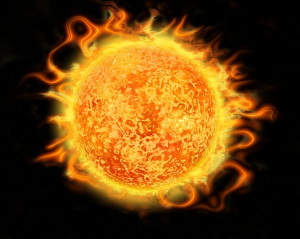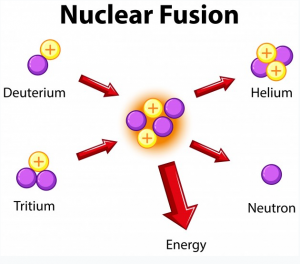Nuclear Fusion technology

A nuclear fusion technology response in which atomic nuclei of low atomic number fuse to form a denser core with the release of energy.
types of nuclear energy
- Nuclear Fusion
- Nuclear fission
Nuclear Fusion
Nuclear Fusion technology is a nuclear response that happens when hydrogen, deuterium and tritium are merged, thus forming a heavier nucleus. Then the core consumes energy in the form of gamma rays and kinetic energy of the released particles. These particles being the neutron and helium. This huge amount of energy modifies matter into a plasma state.
What is Nuclear Fusion
What we notice as light and sense as warmth is the effect of a fusion response in the centre of our Sun: hydrogen nuclei strike, fuse into heavier helium atoms and release tremendous amounts of power in the process.
Beyond billions of years, the gravitational forces at working in the Universe have created the hydrogen clouds of the ancient Universe to gather into massive stellar bodies. In the ultimate mass and temperature of the stars, including Sun, Fusion happens.
Nuclear fission
Nuclear Fission technology is the complete reverse. It is the splitting of one more heavy particle to form two lighter particles.
Production of nuclear Fusion

For nuclear fusion to happen, vast amounts of energy are required. Atomic nuclei are forced to fuse, unlike nuclear fission where the cores are split apart. The power needed is much more significant to form an in a fusion reaction, but the energy produced is four times as much as the energy produced in a fission reaction.
The modern designs for a Nuclear Fusion Reactor can be related to a magnetic bottle. Through a contraption of potent magnets positively charged ions and negatively charged electrons are contained within the central magnetic core structure. Superheated plasma is also kept within this fundamental structure, and it follows the flow of the magnetic stream. Through a neutral-beam injection, highly energised atoms collide with the plasma which they then ionise and increase the temperature of the plasma. This is how the fusion temperature is regulated. This high-temperature situation enables a fusion reaction to take place where tritium and deuterium gas particles are forced to collide under the magnetic pressure then fuse to form a neutron and a helium particle not to mention the energy produced.
The minimum radioactive wastes generated by Fusion are nothing compared to Fission energy, such as low-level mining products to high-level burnt-out fuel rods in fission energy circles. Because of this Fusion energy is a cleaner and more efficient way to produce electricity when put next to Fission Energy.
Why Fusion technology?
Because the world’s population is assumed to grow to 9 billion by 2040, driving global need for electricity up by 45%, meeting this requirement with the technologies accessible today will understand that fossil fuels will remain a primary means of electricity generation. To maintain economic growth while at the same time defeating climate change, we need to generate sources of energy that are emission-free, secure, globally feasible and economically viable.
Fusion has the unique ability to produce utility-scale energy on-demand wherever it is required, making it an attractive complement for intermittent renewables and battery storage. Joined, these technologies make for a robust energy portfolio that moderates climate change while driving economic success.
Why Fusion is stabler than fission
There are a pair of problems with fission reactors—first, the starting material.
Plutonium ( Like uranium, plutonium can also be used to fuel nuclear power plants.)
These starting materials aren’t just laying around. If you continue looking for some natural plutonium, you won’t find any. The only way to produce plutonium is to execute it. The additional problem with fission is the products. Behind this nuclear fission reaction, you have this leftover stuff that can be both radioactive and chemically aggressive. It’s just critical stuff that you have to deal with.
Nuclear Fusion would resolve both of these problems. It begins with more straightforward stuff although deuterium isn’t always so simple to find, you don’t have to make it. After Fusion, you perceive something like helium (or helium-3).
Benefits of fusion technology
- Abundant energy
- Sustainability
- No CO₂
- No long-lived radioactive waste
- Limited risk of proliferation
- Cost
Abundant energy
Fusing atoms in a controlled system releases approximately four million times more extra energy than chemical reactions such as the burning of coal, fuel or gas and four times as much as nuclear fission reactions (at similar mass). Fusion has the potential to produce a variety of baseload energy needed to provide electricity to our towns and our industries.
Sustainability
Fusion fuels are broadly available and almost inexhaustible. Deuterium will be extracted from all forms of water, while tritium will be generated through the fusion reaction as fusion neutrons are associated with lithium. Terrestrial resources of lithium would permit the operation of fusion power plants for more than 1,000 years; on the other hand, sea-based reserves of lithium would fulfil demands for millions of years.
No CO₂
Fusion doesn’t discharge harmful toxins like carbon dioxide or other greenhouse gases into the environment. Its main by-product is helium: an inert, non-toxic gas.
No long-lived radioactive waste
Nuclear fusion technology reactors give no unusual activity, long-lived atomic devastation. An Activation of components in a fusion reactor is less suitable for the elements to be recycled or reused within 100 years.
Limited risk of proliferation
Fusion doesn’t use fissile materials like uranium and plutonium. (Radioactive tritium is not a fissile nor a fissionable material.) There are no fortified materials in a fusion reactor like ITER(the International Thermonuclear Experimental Reactor) that could be utilised to make nuclear weapons.
Cost
The reasonable cost per kilowatt of electricity is also supposed to be similarly slightly extra expensive at the beginning when the technology is unique and less costly as economies of scale bring the costs falling.
Disadvantages of fusion technology
- Nuclear Fusion can only happen between 14999726.85°C to 9999726.85° C
- There are no elements that can cope with 10-15 M Kelvin.
- It will be expensive to build a power plant to produce nuclear Fusion.
- It is not expected to be entirely produced until 2050.
- It’s a non-renewable energy.
- There can also be a radioactive waste.
Read More about Nuclear Fusion technologies